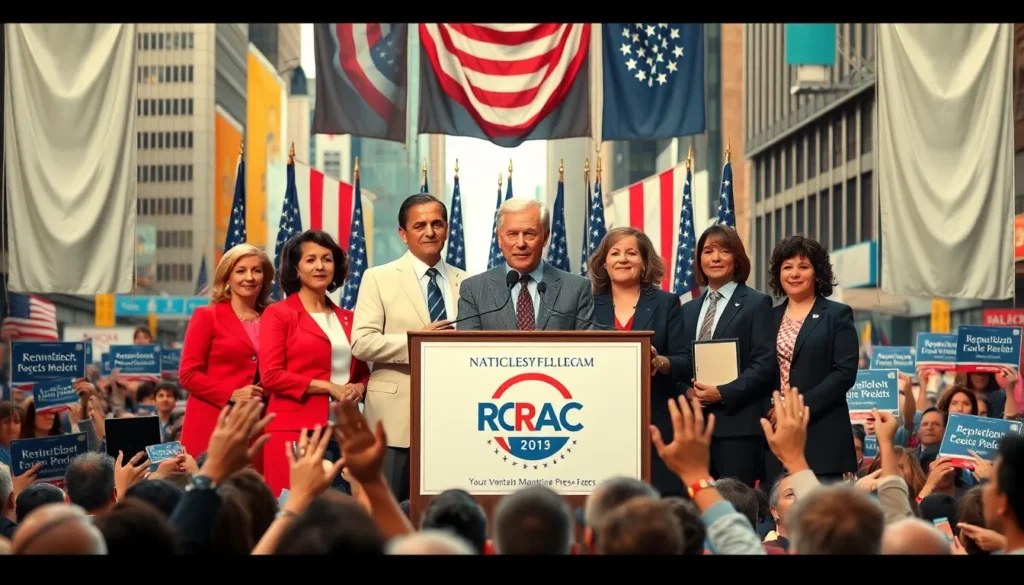As the dust settles from the latest election, political enthusiasts are left pondering a burning question: did the Republicans manage to keep the House? It’s like waiting for the final score of a nail-biting game—except this time, the stakes involve legislation, policies, and a whole lot of political drama.
Table of Contents
ToggleOverview of the 2022 Midterm Elections
The 2022 midterm elections were pivotal in shaping the political landscape of the United States. Voter turnout reached approximately 50%, a significant increase from previous midterms. Various issues motivated citizens, including inflation, abortion rights, and the economy.
Republican candidates aimed to leverage concerns about rising prices and economic uncertainty. In contrast, Democrats focused on maintaining energy around key social issues and healthcare. Exit polls indicated that 63% of voters prioritized inflation as their primary concern.
The House of Representatives saw critical races in swing districts. Republicans needed to secure a net gain of five seats for a majority. Key states like Arizona, Pennsylvania, and Georgia became focal points for campaign efforts. In total, 435 seats were contested, with early indications suggesting a competitive environment.
While results remain pending, early analyses reveal that Republicans may experience challenges retaining their majority. Several incumbents faced unexpected defeats, especially in suburban areas where demographics have shifted. Democratic candidates performed better than anticipated in many battleground districts.
Already emerging trends show a potential for changed leadership dynamics in the House. Voter sentiment demonstrated a clear division, with both parties illustrating strengths in different regions. As counts finalize, further insights into the implications for future legislative actions will develop.
Key Outcomes of the House Races


The recent elections yielded significant outcomes that will shape the House’s future. Republicans faced both victories and setbacks across various districts.
Analysis of Republican Gains
Republicans successfully gained crucial seats in competitive districts. Several swing states demonstrated strong support for Republican candidates, particularly in areas where economic issues resonated with voters. In suburban regions, shifts in demographics played a role in some unexpected gains. For instance, the candidate in Arizona’s 6th district reported a notable increase in votes compared to previous elections. These dynamics suggest that Republican strategies focused on inflation concerns proved effective in certain locales, reinforcing their position in the House.
Factors Influencing Voter Behavior
Voter behavior revealed multiple influencing factors during the election. Inflation topped the list, with 63% of voters stating it was their primary concern. Concerns about the economy drove many undecided voters towards Republican candidates. Additionally, social issues such as abortion rights played a role but did not overshadow economic anxieties. Healthcare remained another focal point, with Democratic candidates emphasizing it in their campaigns. Ultimately, these issues shaped the electorate’s mood leading to varied outcomes across the nation.
Impact of the Republican Retention
Republican retention of the House carries significant implications for future legislative actions.
Legislative Priorities Moving Forward
Republicans are likely to prioritize addressing inflation, given that 63% of voters emphasized this concern. Economic policies may top the agenda, focusing on strategies to curb rising costs and stimulate job growth. Additionally, efforts to reform healthcare and tackle social issues could emerge, reflecting voter interests observed during the midterm elections. Key committees are expected to advance legislation addressing these priorities, which may influence upcoming negotiations with Democrats. Enacting budgetary measures might become a focal point, aiming to gain public support while navigating differing perspectives.
Consequences for the Democratic Party
Democrats face challenges in countering Republican dominance in the House. Shifts in suburban demographics can further complicate their strategies. With significant voter concerns centered around inflation, Democrats must adjust their messaging to retain support. Emphasizing social issues like abortion rights and healthcare might not be enough to sway crucial districts. Future electoral battles may hinge on how effectively they can engage voters disillusioned by recent outcomes. Moreover, some Democratic leaders could face pressure to rethink their approach to governance and collaboration in a divided House.
National Trends and Predictions
Election outcomes reflect emerging national trends that impact Republican control of the House. Voter concerns primarily centered around inflation, with 63% prioritizing it during the midterm elections. Suburban districts, known for shifting demographics, played a pivotal role in many races. Notably, candidates in competitive areas effectively communicated their economic plans, resonating with constituents worried about rising costs.
Recent analyses show that Republicans faced unexpected setbacks in key districts, complicating efforts to secure a majority. In states like Arizona and Pennsylvania, tight races showcased changing voter sentiments. Gains in suburbs, such as in Arizona’s 6th district, highlight how economic issues swayed voters despite demographic challenges.
Predictions for future legislative actions suggest an emphasis on tackling inflation and fostering economic growth. Republican leadership is likely to prioritize policies aimed at addressing these pressing concerns. Efforts may also be directed towards healthcare reform, as voters expressed significant interest in this area during the election cycle.
Democrats are tasked with restructuring their approach to remain competitive. Adjusting messaging to include economic concerns alongside social issues might be vital for re-engagement. The pressure is on some Democratic leaders to rethink strategies in order to connect with disillusioned voters, especially in suburban regions where shifts have been pronounced.
Overall, the political landscape remains dynamic. Tracking these trends will provide insights into the evolving priorities and strategies of both parties in the upcoming legislative sessions.







